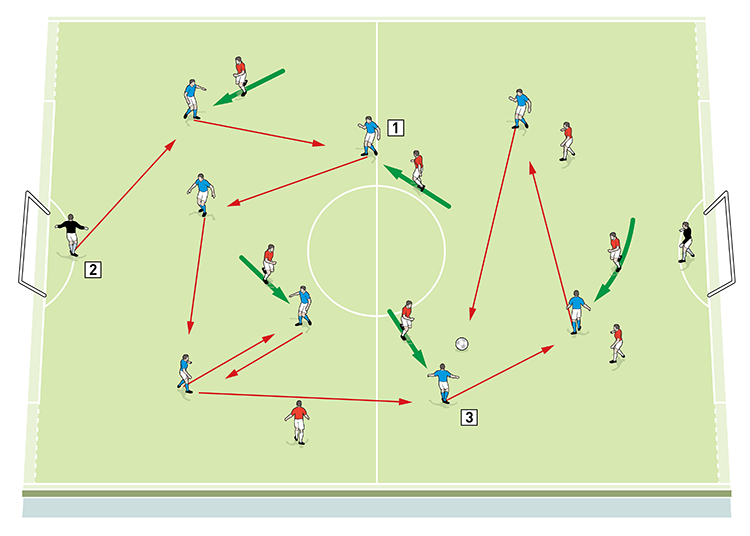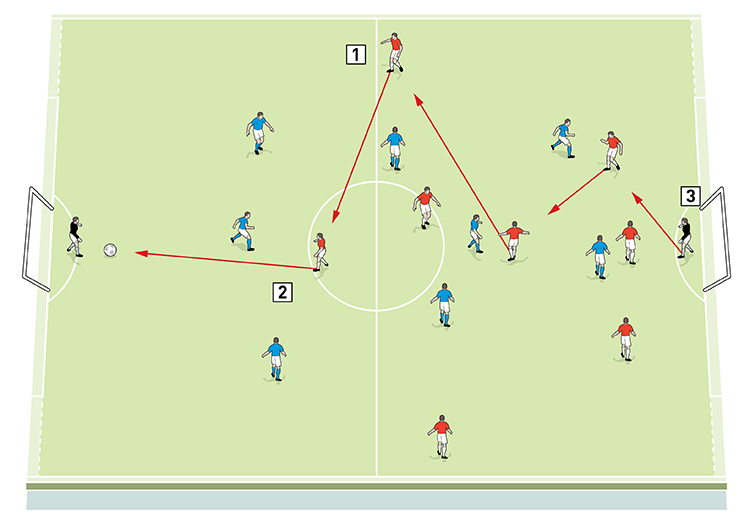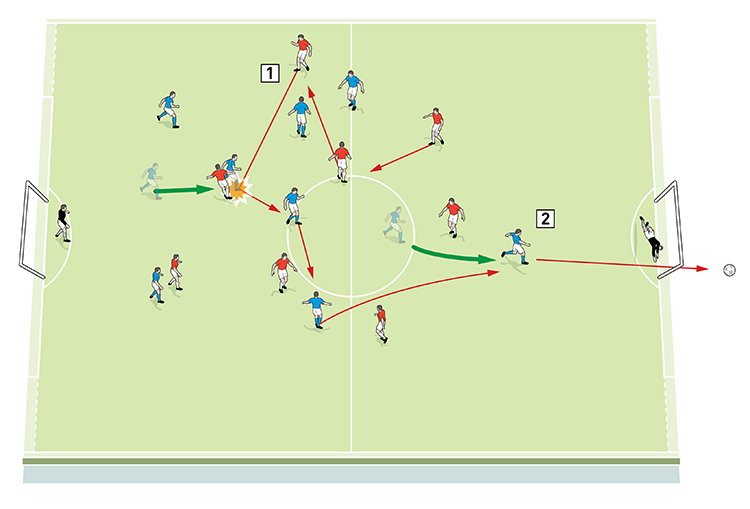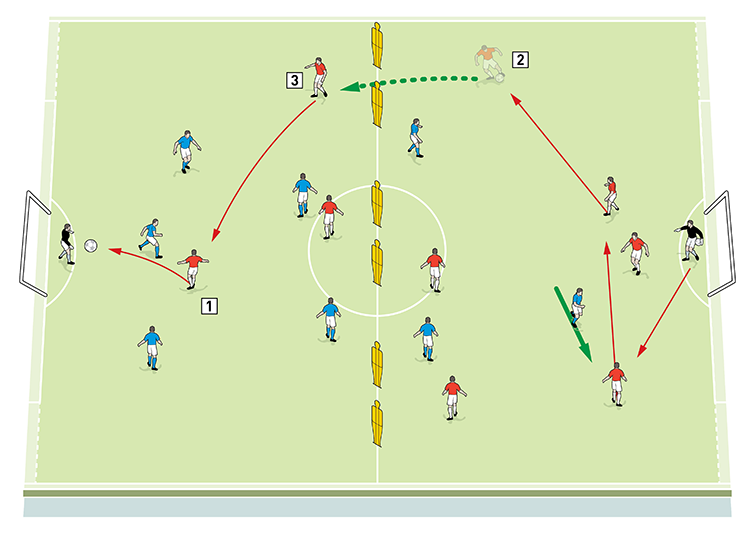You are viewing 1 of your 1 free articles
Reinforcing team fundamentals
The main objective of this session is to make sure players are comfortable on the ball and confident in possession. It focuses on the fundamentals of team play and covers all types of decision making, both defensively and offensively. As it progresses, it adds other elements of the game, such as counter-pressing, counter-attacking, making penetrating forward runs and shooting.
| Area | Two third of pitch |
| Equipment | Balls, bibs, cones, 2 full size goals, 6 mannequins |
| No. of Players | 16 players + 2 goalkeepers |
| Session Time | Each activity: 8mins |
The main objective of this session is to make sure players are comfortable on the ball and confident in possession. It focuses on the fundamentals of team play and covers all types of decision making, both defensively and offensively. As it progresses, it adds other elements of the game, such as counter-pressing, counter-attacking, making penetrating forward runs and shooting.
Here we are running it as a 9v9 session but it is easily adaptable to 10v10 or 11v11. It is also possible to add an overload player into the game to increase the challenge.
Players really enjoy this session as it is set in quite a realistic environment, with numerous ways to score points.
What do I get the players to do?
Non-directional possession
We set up between the penalty areas of our pitch with a full size goal at each end. We’re using 16 outfield players and two goalkeepers divided into two teams of nine. We play a 9v9 game where the objective is to pass the ball and keep possession.
It’s a non-directional game so neither team should attempt to score in the opposition goal – they must simply aim to string 10 passes together without losing possession to score a point, as shown [1].
1

2. Goalkeepers are unopposed and are only used to start play and recycle possession for their team
3. Teams must make 10 passes without the opposition winning the ball to score a point
The coaching focus should be on quick decision making and encouraging players to be smart in keeping the ball. At this stage of the session the goalkeepers are unopposed, so they must not be pressed. We play this game for eight minutes.
How do I progress the session?
Directional possession
After a two-minute break, we play a second 9v9 game with the same set-up as before but this time it’s directional. To score a point, teams must either make 10 passes or successfully pass the ball to the opposition goalkeeper, as shown [2]. In this progression the keepers can now be pressed. We play for eight minutes.
2

2. Teams can also score a point by successfully passing the ball to the opposition goalkeeper
3. The keepers can now be pressed by the opposition attackers
What are the key things to look out for?
In this first progression we want to see if players can focus on keeping the ball and make positive forward passes. From a defending stand point, we want to see that players can switch on defensively and that they can quickly get into shape once the opposition keeper has received the ball.
How do I progress the session further?
Directional possession with counter
After another two-minute break, we play a third 9v9 game with the same set-up as before. Again, to score a point teams must make 10 passes or successfully pass the ball to the opposition goalkeeper, but this time, if teams win possession, they can now counter-attack and must try to score in the opposing team’s goal, as shown [3].
3

2. In this progression if teams win possession, they can now counter-attack and score in the opposition goal
If the ball goes out, play restarts from the keeper. In this progression the added focus defensively is the counter-press, while the offensive focus in on the counter-attack.
Directional possession with dribble
We use the same set-up as before but for this progression we position three mannequin gates on the halfway line. We play another 9v9 game and teams can still score points by making 10 passes, or by passing to the opposition goalkeeper, or by counter-attacking and scoring in the opposition goal, but now players can also score points by dribbling through the mannequin gates and driving into space, as shown [4], or by passing through the mannequin gates.
4

2. Teams can now also score a point by dribbling or passing through the mannequin gates
3. To encourage driving forward into space, players must dribble through the mannequins before shooting or creating a scoring chance for a team mate
If needed, we encourage players to drive through the mannequin gates by adding a condition that players must dribble through them before shooting or creating a chance for a team mate. We play for eight minutes.
Related Files
Editor's Picks
Using the goalkeeper in build-up play
Pressing principles
Intensive boxes drill with goals
Penetrating the final third
Creating and finishing
My philosophy
Pressing initiation
Compact team movement
Defensive organisation
Coaches' Testimonials

Alan Pardew

Arsène Wenger

Brendan Rodgers

Carlos Carvalhal

José Mourinho

Jürgen Klopp

Pep Guardiola

Roy Hodgson

Sir Alex Ferguson

Steven Gerrard
Coaches' Testimonials

Gerald Kearney, Downtown Las Vegas Soccer Club

Paul Butler, Florida, USA

Rick Shields, Springboro, USA

Tony Green, Pierrefonds Titans, Quebec, Canada
Join the world's leading coaches and managers and discover for yourself one of the best kept secrets in coaching. No other training tool on the planet is written or read by the calibre of names you’ll find in Elite Soccer.
In a recent survey 92% of subscribers said Elite Soccer makes them more confident, 89% said it makes them a more effective coach and 91% said it makes them more inspired.
Get Monthly Inspiration
All the latest techniques and approaches
Since 2010 Elite Soccer has given subscribers exclusive insight into the training ground practices of the world’s best coaches. Published in partnership with the League Managers Association we have unparalleled access to the leading lights in the English leagues, as well as a host of international managers.
Elite Soccer exclusively features sessions written by the coaches themselves. There are no observed sessions and no sessions “in the style of”, just first-hand advice delivered direct to you from the coach.









